Join us on our journey.
Become part of a community committed to protecting polar bears with our free newsletter.
Photo: Jenny Wong
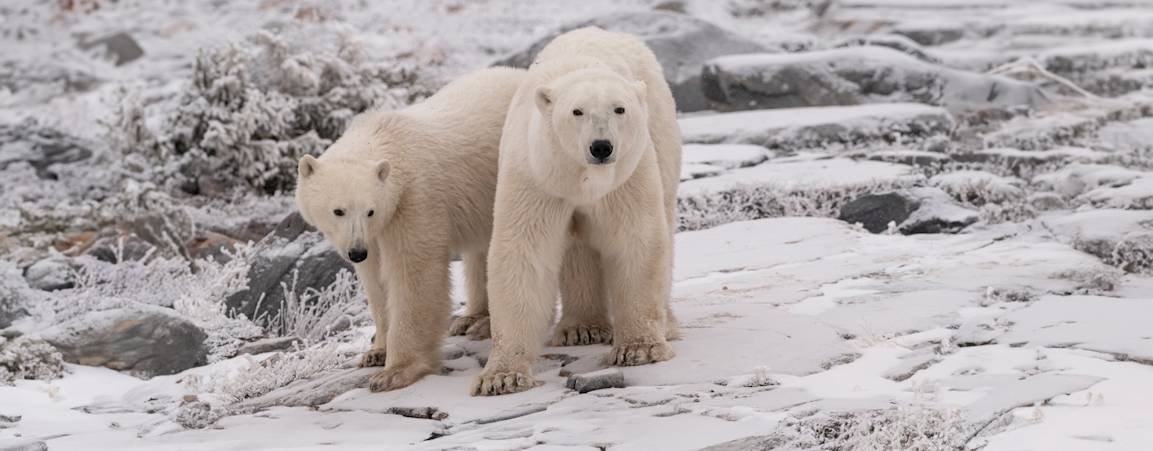
Photo: Jenny Wong
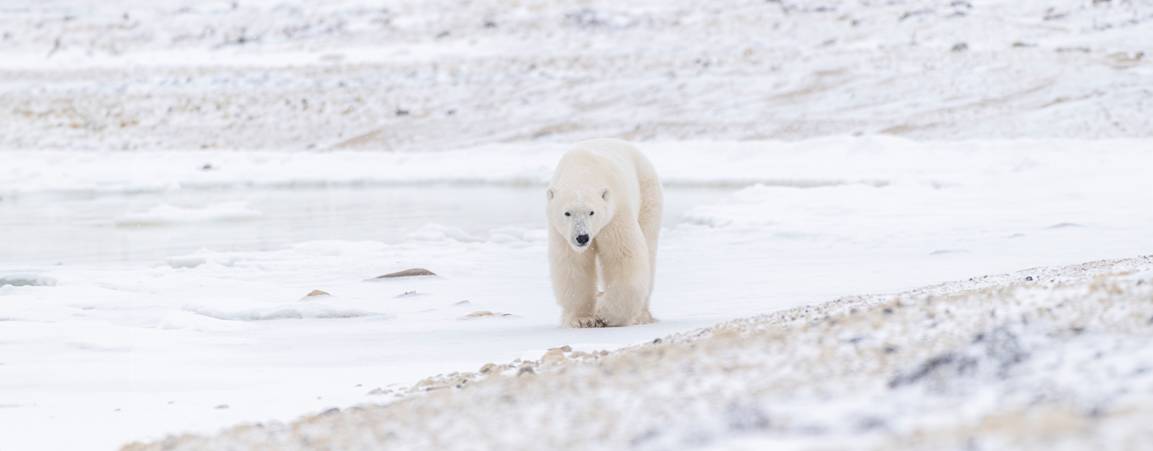
Here is more helpful information to help with planning your trip, including flights, lodging and what to pack.
Round-trip flights to the Winnipeg James Armstrong Richardson International Airport can be made on your own or with a trusted travel agent.
Arrival: We recommend you arrive by late morning / early afternoon on Wednesday, October 28, so you can settle into your room before meeting the group and enjoying the behind-the-scenes tour and welcome dinner at Assiniboine Park Zoo.
Departure: Anytime on Monday, November 2, 2026.
Extending Your Stay: You are welcome to extend your stay in Winnipeg before or after your trip. If you would like to extend your stay at The Grand Winnipeg Airport Hotel by Lakeview, please contact travel@pbears.org to make the necessary arrangements. Refer to the “Things to Do in Winnipeg” section for ideas.
Winnipeg Accommodations
The Grand Winnipeg Airport Hotel by Lakeview
Our journey includes a pre- and post-night stay at The Grand, a contemporary boutique hotel conveniently located adjacent to the Winnipeg Airport. The hotel features a bar, a lounge and Blue Marble Restaurant..
Transportation from the airport: The Grand is within walking distance from the Winnipeg Airport. Recommend using a luggage cart from the airport to transport your luggage to the hotel.
Check-in: 3:00 pm. The hotel will do everything possible to accommodate early arrival requests based on availability.
Meet & Greet / Dinner – October 28: Enjoy a meet & greet dinner event at Assiniboine Park Zoo Gateway to the Arctic exhibit on Wednesday, October 28. You will be joined by your Frontiers North interpretive guide, who will discuss tour information for your upcoming Churchill adventure.
Luggage / Breakfast / Flight – October 29: 5:30 am - At this time, luggage must be brought down to the hotel lobby. Luggage is transferred to the aircraft separately.
**Upon arrival at the Churchill airport, you will not have immediate access to your baggage as it will be transferred directly to your accommodation. Please bring all necessary clothing, camera gear, and medications on the flight to prepare for the day's activities.**
05:35 am - Enjoy a hearty breakfast at the hotel.
06:30 am - Meet in the hotel lobby to transfer to the chartered aircraft for our flight to Churchill.
Churchill Accommodations
Tundra Buggy Lodge
The Tundra Buggy Lodge is a unique experience for our Tundra Celebration guests.
What is the Tundra Buggy Lodge?
The Tundra Buggy Lodge is Frontiers North's pop-up hotel, located in the Churchill Wildlife Management Area (CWMA), which is the heart of polar bear country. The Lodge consists of two accommodation units for our guests, a lounge, a dining hall and staff quarters. Outdoor viewing platforms connect each unit and allow for outdoor photography. Situated far from the lights of town, it's the perfect place to view bears all day long and have optimal northern lights viewing at night (weather permitting). The lodge also has exterior field lights that enable us to continue watching the bears even after the sun sets.
Staying on the Tundra Buggy Lodge
The Tundra Buggy Lodge is unlike a regular hotel and can only be accessed through packaged tours. While onboard, Thanadelthur Lounge is where guests are invited to mingle before and after dinner to share photos and stories about their exciting day on the tundra. After dinner, guests can partake in presentations from Polar Bears International representatives and Frontiers North staff. Thanadelthur Lounge has WiFi access and is the best place to view the northern lights, with panoramic views from the wall-to-ceiling windows and roof-top observation deck.
Accommodations at the Tundra Buggy Lodge
The accommodation units, named Hearne and La Perouse after two important figures in Churchill's history, consist of 10 upper and 10 lower sleeping berths, each with a window, a reading light and four 110-volt electrical outlets. Each berth houses a standard twin-sized coil mattress. A sound-dampening curtain provides privacy by separating the berths from the aisle.
In addition, each 20-person accommodation unit has three bathrooms, two of which are equipped with showers.
Food on the Tundra Buggy Lodge
The lodge has a private chef who makes delicious home-cooked meals each day. I would like a hot breakfast, cereal, coffee/tea in the morning, homemade soup and sandwiches for lunch, and local cuisine such as Arctic char, bison, or elk for dinner. The chef can also accommodate special dietary requirements with prior notice.
A Typical Day
Please note, this is a guideline to a typical day and actual times may vary.
Guests are served a buffet breakfast between 7:00 am and 7:50 am. After breakfast, guests will board their Tundra Buggy and spend about 8 hours in the Churchill Wildlife Management Area. Snacks, refreshments and a picnic-style lunch are provided throughout the day. Upon returning to the Tundra Buggy Lodge, guests are invited to unwind and socialize in Thanadelthur Lounge before heading for dinner. After dinner, guests will either have free time or have a presentation from one of Polar Bears International's team staff. Thanadelthur Lounge remains open 24 hours a day for the night owls and early birds of the group.
A friendly reminder that due to the nature of remote travel to the North, comprehensive travel insurance coverage is mandatory for participation in all Frontiers North Adventures package tours, including without limitation medical (recommended minimum $100,000), emergency evacuation (recommended minimum $750,000), trip cancellation and interruption coverage, per person. Frontiers North Adventures requires proof of trip cancellation, interruption, and emergency medical insurance by your final payment date.
Frontiers North Adventures’ preferred provider is Redpoint Travel Insurance. For coverage, contact Redpoint at +1-415-481-0600 or purchase online here.
Once you have your travel insurance policy, upload the details in your guest portal.
All guests on this trip must sign the Polar Bears International travel waiver before departure. Please use this link to access your waiver.
All international travellers are required to have passports to enter Canada. Well before your departure, visit the Government of Canada’s Citizenship and Immigration website for more information. All travelers to and from the United States are required to have a passport. For more information, visit travel.state.gov.
The currency in Winnipeg and Churchill, Manitoba, is the Canadian dollar (CAD). Credit cards are accepted at most businesses. In addition there is a limited number of cash machines in Churchill.
To ensure the current exchange rate, visitors can exchange their funds at any Canadian financial institution, bank, trust company, credit union, or exchange booths at border entry points. Although U.S. money is readily accepted in Manitoba, using Canadian cash is recommended.
Photo: Jenny Wong
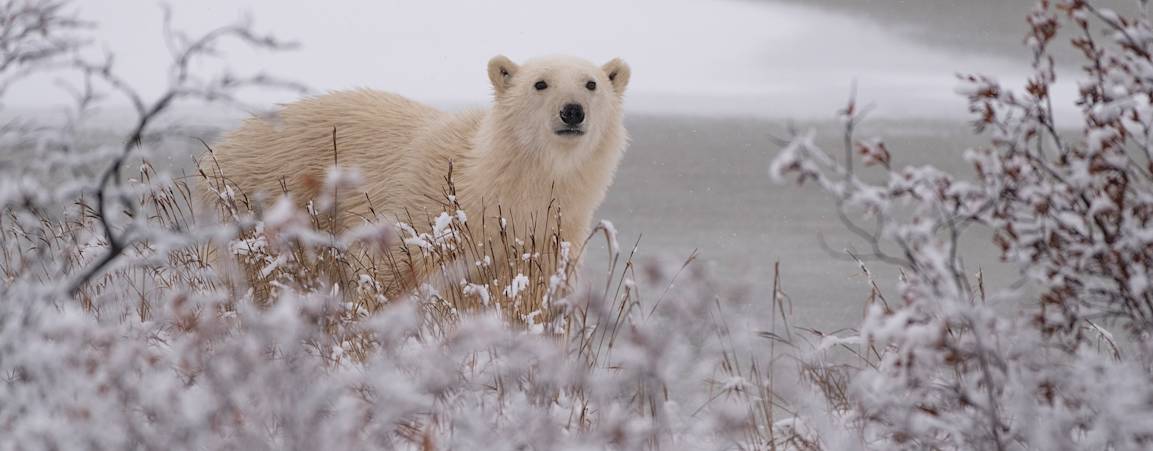
Be Prepared – Packing for Churchill
Churchill's weather can be very variable in the winter. Temperature can vary from -13˚C to -2˚C (9˚F - 29˚F), but often strong winds can push the temperature down several more degrees (the ‘wind chill’ factor). The Tundra Buggies are heated; however, dressing in layers is the best way to stay comfortable.
Here is a list of items that we recommend you pack for your time in Churchill:
Warm hooded parka
Long underwear or thermal layers
Snow/ski/wind pants
Warm sweater and/or hooded sweatshirt
Wool-blend socks
Warm gloves/mitts and thin gloves
Hat, Scarf, neck warmer or similar gear to cover and protect your face against the cold north winds
Warm-rubber-soled winter boots
Slippers (it is a nice perk for the Tundra Buggy Lodge)
Day pack that zips, cinches, or buckles closed (to bring gear and extra layers for Buggy days)
Binoculars, camera, extra camera batteries, memory cards, and hard drive, if you plan to take a lot of photos
See the Photography & Binocular Guide section for additional information
Reusable, sealable travel mug or water bottle
Note: You will receive a Polar Bears International water bottle upon your arrival at the Tundra Buggy Lodge.
Checked baggage for all flights must be limited to one piece per guest for a maximum total of 23kg (50 lbs) and not be larger than 62 in (158cm) (L+W+H). Each guest is allowed two carry-ons, including personal items, for a maximum combined weight of 9kg (20lbs).
The maximum dimensions permitted for carry-on baggage is 10in x 16in x 12in (25cm x 40cm x 30cm). Carry-on that exceeds these dimensions will be considered checked baggage and will have to be stored in the general baggage compartment. Space permitting and if able to be safely stowed, additional items such as coats, medication bags, a cane, CPAP, etc. may be permitted in the cabin.
Photographers: Calm Air will permit you to gate check your standard carry-on sized bag that is too big to fit in the overhead. This is useful for large camera backpacks and roller bags containing camera gear. These bags will be hand carried on board by the flight crew and stored in a separate cargo hold, and is typically safer than checking the bag as usual.
Don’t have your own winter gear? Frontiers North Adventures offers gear rentals for your trip, including Canada Goose parkas, snow pants, and Baffin winter boots.
Photo: Dave Sandford
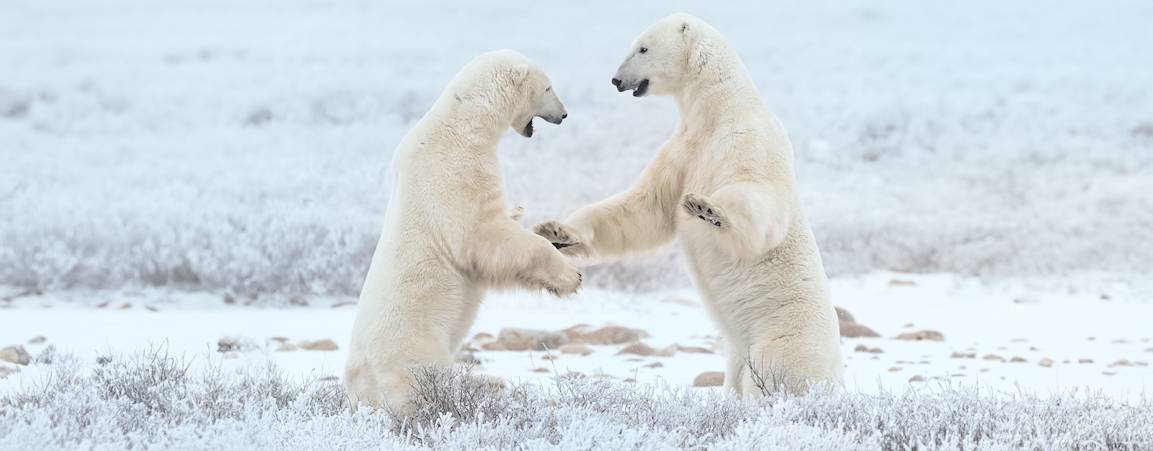
Capturing memories through photography is a big part of travel! Whether you're a professional or just enjoy snapping pictures, here are some key tips to help you get the best shots. Also, please check our policy on drones and our recommendations for binoculars. By preparing the right gear, you’ll make the most of your adventure!
Photography Tips
Camera & Equipment:
Test your camera before your trip, especially if it’s new or hasn’t been used in a while.
Bring your camera manual in case you need troubleshooting help.
Batteries:
Batteries drain faster in cold climates—always pack extras!
Digital Storage:
Bring more digital storage than you think you’ll need to avoid running out of space. Bring multiple memory cards and a hard drive to offload photos if you are worried you will run out of space.
Tripods:
Great for land excursions.
Maintenance & Storage:
Use a microfiber cloth to keep your lens clean.
Protect your camera from water, moisture, and shock with a sturdy bag.
Binoculars Guide
Good binoculars can greatly enhance your wildlife viewing experience!
Recommended Specs: Look for 8x32 or 10x42 models for a good balance of magnification and brightness
Wide-field binoculars help spot wildlife more easily.
Compact models (8x25) are lightweight but may compromise brightness.
Rubber-coated & waterproof options are best for durability.
Spotting scopes offer incredible detail but are not ideal for use on the ship due to vibrations—best for land excursions.
Drones
IMPORTANT: Regarding unmanned aerial vehicles (UAV), commonly known as drones, Polar Bears International does not allow guests to use UAVs.
Dinner is included on October 28, the first night of our journey. If you arrive early or extend your time in Winnipeg, we suggest the following dining options and activities.
Dining Suggestions
Smith Restaurant (Inn at the Forks)
Forks Market (walking distance from the Inn)
Clementine Cafe (breakfast and lunch, less than 10-minute drive from the Inn)
Cibo Waterfront Cafe (~4 min drive, ~20 minute walk along the Red River from the Inn)
James Avenue Pumphouse (~4 min drive, 20 min walk along the Red River from the Inn)
Activities
Canadian Museum for Human Rights (walking distance from the Inn, Tue-Sun)
Winnipeg Art Museum (less than 10-minute drive from the Inn)
The Forks National Historic Site (walking distance from the Inn)
The Forks Historic Port and River Walk
Riverstone Spa (Inn at the Forks)
Enjoy Yourself
Churchill is one of the most incredible places in the world. This gateway to the Arctic allows you to immerse yourself in one of the most fragile and unique ecosystems on Earth.
Be Flexible
We are in the north, after all. You never know what will happen. Expect anything and be ready to roll with the punches; weather can be unpredictable, and resources are limited. Be prepared for changing elements.
The days are longer during October and decrease in length as November progresses. You can expect approximately 7-10 hours of daylight during October and November.
Staying Connected
Polar Bears International will set up a WhatsApp group to facilitate communication in Churchill. Please be sure to download WhatsApp on your phone and accept the invitation prior to your arrival.
Cell services and internet are available in Churchill, especially when you are at your hotel. However, connectivity may be limited at some locations, especially outside of town.
Town Amenities
Churchill has a grocery store and liquor mart. The Churchill Town Centre Complex houses a health centre, school, library, swimming pool, indoor playground, curling rink, theatre, hockey arena, gymnasium and fitness centre. Interior walkways, lit by overhead skylights, are lined with brightly coloured Inuit wall hangings and prints, and a big carved-wood polar bear invites children to slide through his benign mouth.
Many of the listed sites may be included in your tour of Churchill. You can also check out Frontier North’s recommended spots on their winter pre-departure web page.
Cape Merry
A short trip west of Churchill, you will find Cape Merry National Historic Site and a beautiful view of the mouth of the Churchill River. Managed by Parks Canada, this site is the former cannon battery designed to complement Prince of Wales Fort, visible on the other side of the river. The cape is an excellent vantage point for observing the Beluga whales that frequent the tidal area of the river throughout the summer.
Churchill Northern Studies Centre
The people of Churchill, with cooperation from the Government of Manitoba, established The Churchill Northern Studies Centre (CNSC) in 1976. It is a non-profit charitable corporation with a mandate to facilitate arctic research and education. The CNSC hosts climate change research projects, the Canadian Wildlife Service polar bear project and long-term bird behavior and survival studies to name a few.
Churchill Rocket Research Range
The Churchill Research Range (CRR) was established in 1957, the International Geophysical Year, to launch sounding rockets carrying experimental payloads into the upper atmosphere. It was operated by various agencies, launching over 3,500 rockets when it closed in 1985. The Canadian Space Agency operated the range in 1989 for a series of NASA launches. In 1994, Akjuit Aerospace signed a 30-year lease with the Manitoba Government for the former CRR and the surrounding area, totalling 80 square kilometres. Over the summer of 1994, Akjuit restored the Sounding Rocket facilities to operational levels, renaming the site Space Port Canada. Akjuit then proceeded to add launch facilities for much larger rockets. Akjuit ceased to pursue this dream in June of 1998.
Itsanitaq Museum
Home to one of the most comprehensive collections of Inuit artifacts and sculptures, the Itsanitaq (formerly Eskimo) Museum is unique. It is run by the Diocese of Churchill and, founded in 1944 by Roman Catholic Missionaries, is dedicated to advancing knowledge, understanding, and appreciation of Northern culture and history.
Your tour will include a visit to this informative landmark. You will also discover that the museum is an excellent source of books, including some of the books we recommend in our recommended reading list.
Parks Canada Visitor Center
Situated in the center of Churchill, the Parks Canada Visitor Center serves as an information hub with interactive exhibits. Stop by to learn more about the ecology and history of Wapusk National Park and the surrounding area.
Prince of Whales Fort National Historic Site
In 1731, the Hudson Bay Company commissioned building a massive stone fortress called the Prince of Wales Fort on a rocky peninsula known as Eskimo Point. The HBC hoped that this fort, situated at the mouth of the Churchill River with forty-two cannons and 40-foot thick walls, would provide refuge for the company ships at war with France. The French, however, ultimately destroyed Prince of Wales Fort after being surrendered without firing a shot in 1782.
Wapusk National Park
The geology, biodiversity, and cultural history of Wapusk National Park make it one of the most unique wilderness areas on the planet. The name Wapusk means “White Bear” in Cree. At 11,475 km², the park protects one of the largest known polar bear maternity denning areas and lies on the transition between boreal forest and Arctic tundra. Tundra Buggy Tours operates on the northern edge of the park.
Fall is Churchill’s polar bear season, meaning this time of year is when they are most active in the region. Always practice bear safety during your time in Churchill.
Polar bears spend much of their year roaming the ice of Hudson Bay hunting seals. When the ice begins to melt in July, the bears come ashore and remain on land until the bay freezes over in late November. While on land in the summer, the bears eat little and are quite inactive. But as fall approaches, they begin to move northward along the coast and congregate where the first winter ice forms. This annual movement brings many bears into the town of Churchill each year.
Polar Bear Alert Program
Manitoba Conservation, the town of Churchill and its Churchill Bear Smart Group have worked hard to educate the people of Churchill and visitors about polar bears and how to avoid potentially dangerous situations.
IF YOU ENCOUNTER A POLAR BEAR
Stay calm
Stay with your group
Back away, facing the bear at all times
Do not turn and run away
Do not play dead
Get into your vehicle or a building as fast as possible
Call the Polar Bear Alert line at 204-675-2327 (204-675-BEAR)
Polar Bear Safety Video
Polar Bears International supported the efforts of the Churchill Bear Smart Group in producing a video for residents and visitors on how to stay safe around polar bears, based on the town's unique situation as a global destination for polar bear viewing. The approach can be adapted for use elsewhere.
Photo: Jenny Wong
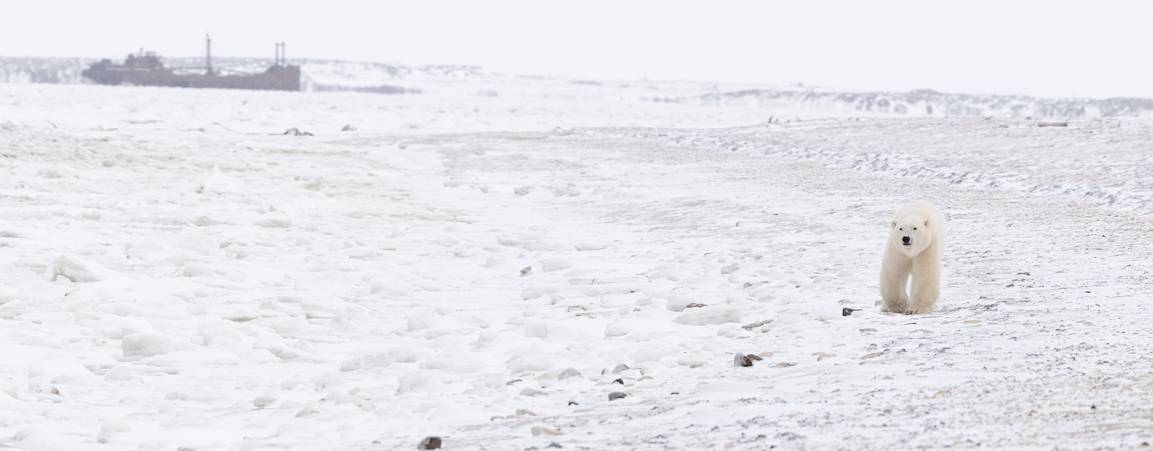
Did you know that Churchill is known as the polar bear and beluga capital of the world? Here is the Polar Bears International staff’s recommended reading list to learn more about polar bears, beluga whales, Churchill, and Hudson Bay.
Churchill Hudson Bay by Lorraine Brandson
Written by Lorraine Brandson, curator of the Eskimo Museum, this publication outlines various aspects of the natural and cultural heritage of the region. Focus has been placed on numerous themes, including aboriginal history, the fur trade, the Hudson Bay railway, geology, paleontology, atmospheric science, the flora, Hudson Bay, and the abundant biodiversity of life: from sea urchins to arctic terns, to belugas, to Churchill’s most famous citizen, the polar bear.
Polar Bears: A Natural History of a Threatened Species by Ian Stirling
Dr. Ian Stirling compresses the major discoveries of the last 40 years of research on this iconic mammal into a new, easily readable and scientifically comprehensive book about the ecology and natural history of polar bears. He explains how polar bears evolved, how they were researched, aspects of their behavior and how the threat of global warming jeopardizes this magnificent hunter's survival.
Polar Bears: A Complete Guide to Their Biology and Behavior by Andrew E. Derocher
Through informative and engaging language, Derocher carefully explains the sea ice ecosystem that is essential to the survival of polar bears. He addresses the threat of global warming to the Arctic—home to polar bears for tens of thousands of years—and describes their feeding habits, distribution, den ecology, and reproduction in detail. Lynch’s vivid photographs capture all this and more as they chronicle polar bear behavior from family rituals to ferocious predatory practices.
Photo: Jenny Wong
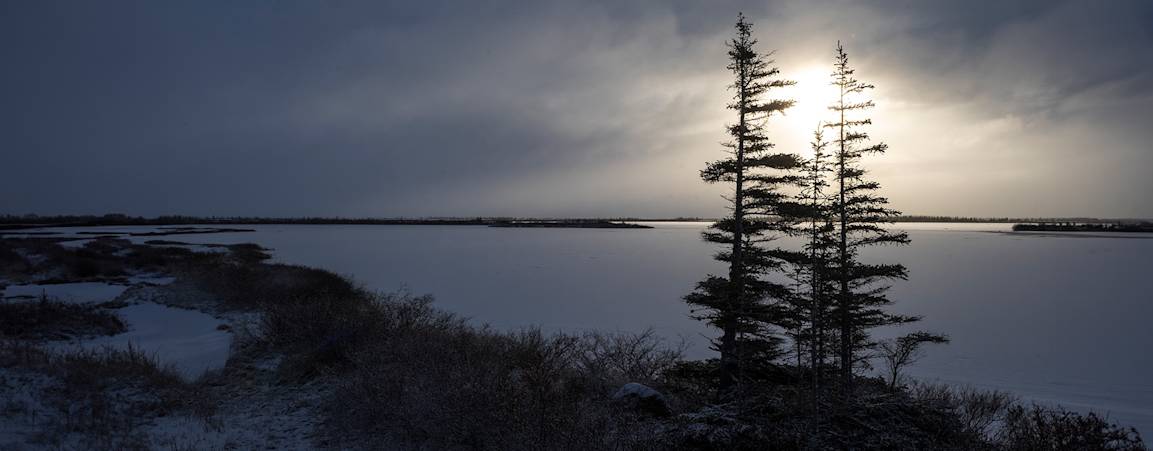
Polar Bears International (PBI) House

The PBI House was completed in 2019 through a generous lead gift from the Reiss Family Foundation. Since then, it’s become a meaningful community asset and serves as a gathering place for members of the Churchill community. It’s also the home to our Interpretive Center, which educates Churchill visitors about polar bears, climate warming, and the urgent need to act. During other times of the year, it serves as a venue for Churchill community needs and supports visiting researchers and educators.
Mars Arctic Conservation and Research Centre

The Mars Centre was completed in 2020 through a generous donation from the Mars family (yes, Mars candy bars). The color scheme was inspired by the black-and-white buggies that took researchers to bear-watching sites. The Mars Centre primarily houses full-time and logistics staff in eight bedrooms with four shared bathrooms upstairs. Downstairs is home to our family-style kitchen and gathering space where we nourish and host our team. An office downstairs provides space for our daily morning meeting during the tourist season.
Tundra Connections
We stream live, free webcasts from Buggy One every fall. Viewers around the world tune in to meet and talk with world-renowned scientists and educators as polar bears roam outside. Our Tundra Connections webcasts are typically held during our annual awareness days, including International Polar Bear Day (February 27), Arctic Sea Ice Day (July 15), and Polar Bear Week (late October/early November).
Learn more about Tundra Connections and PBI Awareness Events.
Polar Bear, Northern Lights, and Beluga Live Cams
This partnership with Explore.org, Frontiers North Adventures, the Churchill Northern Studies Centre and Parks Canada helps us reach a worldwide audience, educating viewers and inspiring them to care.
Learn more about the cams.
Field Ambassador Program
Polar bear experts worldwide volunteer to join guests on Frontiers North Adventures Tundra Buggies and provide educational programming at PBI House, offering a venue for questions and information about polar bear research and conservation efforts across the Arctic. You may meet one of our field ambassadors at the PBI House during your stay.
Bear-dar: Detect to Protect System
As sea ice declines, more polar bears will be driven ashore, with some venturing into communities in search of food. This project tests whether surveillance radar can detect approaching bears, triggering an alert before they reach town.
Learn more about Bear-dar.
Polar Bear Safe Communities
Polar Bears International has been supporting the efforts of the town of Churchill, Manitoba, to establish the world’s first polar bear-safe community. This is the next step in a drive to minimize negative encounters between people and polar bears so both can thrive.
Learn more about our coexistence work.
Photo: Jenny Wong
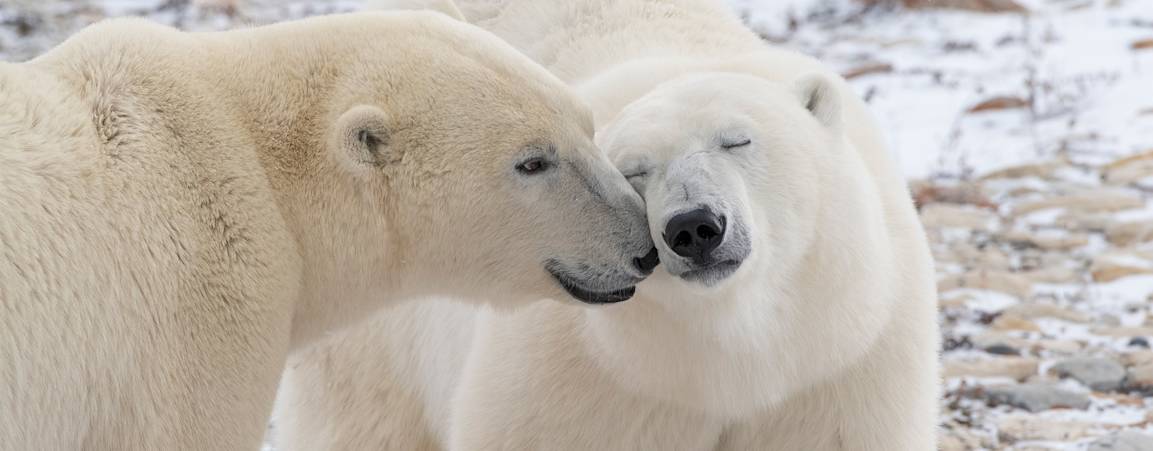
Details coming soon!

Become part of a community committed to protecting polar bears with our free newsletter.